CONDIMENTS & SPICES
A. Introduction to Indian food
B. Spices used in Indian cookery
C. Role of spices in Indian cookery
D. Indian equivalent of spices (names)
A. Introduction to Indian food
B. Spices used in Indian cookery
C. Role of spices in Indian cookery
D. Indian equivalent of spices (names)
Introduction to Indian food
Think of India and one of the first things that comes to mind is its diversity. A large country, its population is second only to China, its languages are numerous and every state (of which there are 28 and seven Union territories) is unique in its traditions and very importantly, its food. In fact, food from one region may actually be totally alien to a person from another region! The common thread that runs through most Indian food though, is the use of numerous spices to create flavor and aroma.
Indians take their food very seriously. Cooking is considered an art and mothers usually begin to teach their daughters and pass down family recipes by show-and-tell, fairly young in life. Mealtimes are important occasions for family to get together. Most meals comprise of several dishes ranging from staples like rice and breads to meat and vegetables and rounded off with a dessert. In a lot of Indian homes, foods are made from scratch with fresh ingredients. For example, some families buy their favorite type of wheat, wash it, dry it in the sun and then take it in to a flourmill to have it ground into flour exactly the way they like, as opposed to buying flour from a store! This is changing in bigger cities where people have increasingly hectic lives and are happy to use ready-to-eat, pre-made ingredients.
Role of spices in Indian cookery
It’s hard to imagine cooking without spices. Spices are natural flavouring elements most often in dried form but sometimes fresh. A spice is a dried seed, fruit, root, bark or vegetative substance used in nutritionally insignificant quantities as a food additive for the purpose of flavouring. So accustomed are we to the richness of flavour, vibrancy of colour and the delicacy of aroma that the food we eat would be sadly lacking without these vital ingredients. Cooking with spices goes a long way to achieving a cook’s desire to serve delicious food. Today’s enthusiasm of trying different foods and flavours lies behind much of the growth in the availability of spices.
The role of spices in cooking has never been in question. Spices have been traded for over 7,000 years and played a major role in the development of Civilization. Wars were fought and lands explored and colonised in an attempt to find new ways of obtaining spices from the Orient and gaining control of established routes. The great thing is the availability of good spices now. Spices tend to be associated with cooking to enrich and give a distinctive depth of colour and flavour to food. Different spices like basic spices including powder spices and whole spices are often used together to wonderful flavours to certain styles of cooking. Spices add a whole new dimension to cooking. Each of these spices has its own distinctive colour and flavour. Indian spices have been used for hundreds of years to flavour food. We must salute to the role that these foodstuffs play in our cooking. Let us give them the respect they deserve and allow them to provide the maximum flavour and pleasure they can to our cooking.
Fresh ground spices are the order of the day in any home and will be chosen according to the nature of the dish, season, and family. The role of spices goes beyond cooking. Ayurveda prescribes spices for curative and therapeutic functions. Most spices used in cooking are very healthy, and make the digestion process much easier. Spices have been used to make the food last longer in the days when refrigerators were not available. Integral to cooking all year round, spices are supremely important to have in your kitchen. Spices are high in flavour yet low in fat, calories and sodium. Spices offer the opportunity to explore new tastes.
Indian food is characterized by its sophisticated and subtle use of many spices. Each single spice used in Indian cuisines carries some or the other dietary as well as medicinal properties. Spices are frequently used to heighten culinary appeal. Spices are also used in large amount in the kitchens for flavouring and preserving food. Spices not only flavour and improve the taste of the food, but supply us with many nutritional prophylactic substances. Recent scientific studies have revealed the important role these spices play in maintaining good health. Apart from adding colour, flavour and taste, consumption of spices provide infinite health benefits. Spices are used for many home remedies. You can be more creative in use of spices if you know its uses better.
Having the right spices and ingredients in your kitchen will help you start your journey into the wonderful world of cuisine. Spices play an integral role in cooking. Many spices also have medicinal properties and are used for many home remedies. In use, ground spices do have certain well-established advantage over other forms of seasoning. We primarily depend on spices for flavour and fragrance as well as colour, preservation and inherent medicinal qualities. Spices have played a vital role in world trade, due to their varied properties and applications.
Spices are consistent in flavour and have a much longer shelf- life. They are easier to store and are not affected by bacterial contamination. They can be blended and used as per individual choices. They release their flavour fully on cooking or adding to the food and retain their flavour for a long time. It is said that some spices have antioxidant potential equal to fresh produce and can further reduce the risk of developing heart disease and certain cancers. Even leading dieticians agree that spices must be included in one’s diet to enhance the flavour of food and make it more interesting and may provide long-term health benefits. They can be conveniently added to day to day cooking, are inexpensive, are readily available and always in season, and by their essence, highly palatable and easily consumed”.
The Right Ways to Use Spices in Cookery
Same recipe cooked by different people tastes different. Cooking is a skill, an art which one can learn by experimenting and using different spices and herbs. There is a whole range of spices to choose from but one has to know these spices and their correct usage.
Spices add flavor, colour and taste to a dish. One has to understand the right ways to use these spices. Always use herbs and spices discretely, more does not mean more taste, it can spoil the taste of the food.
Ways to add spices to Food for maximum flavor:
- Use spices and herbs to improve the natural aroma of the food, do not mask the flavor.
- Crush dry herbs just before adding these to the food. This gives a better flavor. Fresh herbs must be added at the end of the cooking for maximum aroma.
- Do not use two strong flavoured herbs together. Always use one strong flavoured and one herb or spice with mild flavor.
- While removing spices or herbs from the container use a dry spoon.
- To get a blended flavor add herbs at the beginning of the cooking. But if you want a distinctive flavor then add herbs at the end of cooking.
- Whole spices are best to use in dishes that take long to cook as these discharge the flavor slowly.
- Ground herbs and spices give out flavor very easily and fast. In dishes that take long to cook like curries and stew, add ground spices towards the end of the cooking.
- Foods that are not cooked or cold dishes like salads, fruits and juices, add spices and herbs many hours before the food is served to allow the flavous to blend well with the food.
- While following a recipe, if you increase the quantity two times do not use double the amount of spices, add only 50% more.
spices used in indian cookery with names
List of Indian spices
| Image | Standard English | Indian English | Hindi | Marathi | Gujarati | Tamil | Malayalam | Telugu | Kannada | Bengali | Urdu | Notes | |
|---|---|---|---|---|---|---|---|---|---|---|---|---|---|
| Alkanetroot | Ratin jot | रातीं जोट | रक्तमूळ | রতনজোট | |||||||||
 | Aniseed[1] | Suwa or Shopa | सुव्वा / शोप | चक्रिफुल | સૂવા | సోంపు | ದೊಡ್ಡ ಸೋಂಪು | মৌরি | سونف | ||||
 | Asafoetida | Hing | हींग | हिंग | હિંગ | பெருங்காயம் | കായം/പെരുംകായം | ఇంగువ | ಇಂಗು | হিং | ہنگ | Intensely aromatic - related to Truffle and Garlic | |
 | Yellow pepper | Laal simala Mirchi | Red capcicum | குடை மிளைகாய் | മഞ്ഞ കാപ്സികം | ದೊಣ್ಣೆ ಮೆಣಸು | হলুদ ক্যাপসিকাম | پیلی مرچ | |||||
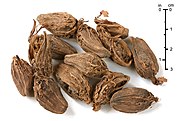 | Black cardamom | Kali Elaichi | काली इलाइची | वेलची | એલચો | കറുപ്പ് ഏലക്ക | నల్ల ఏలకులు | বড় এলাচ | الائچیکالی | Very earthy and darkly aromatic. A much used in North Indian curries. | |||
 | White pepper | Safed Mirchi | सफ़ेद मिर्च | पांढरी मिरी | வெள்ளை மிளகு | വെള്ള കുരുമുളക് | తెల్ల మిరియాలు, | ಬಿಳಿಮೆಣಸು/ಬಿಳಿ ಕಾಳುಮೆಣಸು | সাদা মরিচ | سفید مرچ | |||
 | Black pepper | Kali Mirchi | काली मिर्च | काळी मिरी | મરી | மிளகு | കുരുമുളക് | నల్ల మిరియాలు, | ಕರಿಮೆಣಸು/ಕಾಳುಮೆಣಸು | গোল মরিচ gol morich | مرچکالی | Largest producer is the southern Indian state of Kerala. | |
 | Peppercorns | Kali Mirch | काली मिर्च | काळी मिरी | mari | மிளகு | കുരുമുളക് | miriyalu, మిరియాలు | ಕರಿಮೆಣಸು/ಕಾಳುಮೆಣಸು | গোল মরিচ | مرچکالی | ||
 | Black Cumin not kala zeera/kalonji | Shah Jeera | शाही जीरा | शहाजिरं | கருஞ்சீரகம் | കരിഞ്ജീരകം | నల్ల జీలకర్ర, | ಕರಿ ಜೀರಿಗೆ | শাহ্ জিরা | شاہ زیرہ | Sweet, floral and smokey cumin and anise-like flavour. Smaller in size than regular cumin. Often mistaken as Carawayseed. Though English translation isBlack Cumin, the term black cumin is also used as English translation ofNigella sativa, kalonji | ||
 | Capers | Kachra | कचरा, कब्र, करेर | கரியல் | మరాఠీ మొగ్గు, ముముదాటు, | ಮರಾಠಿ ಮೊಗ್ಗು | কাবরা | کرر | also known as Kabra, Karer in Hindi | ||||
 | Capsicum | Shimla Mirch | शिमला मिर्च | सिमला मिरची/भोपळी मिरची | ದಪ್ಪ ಮೆಣಸಿನಯಕಾಯಿ/ದೊಣ್ಣೆ ಮೆಣಸಿನಕಾಯಿ | ক্যাপসিকাম | شملہ مرچ | ||||||
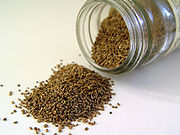 | Celery / radhuni seed | Ajmud | अज्मुद,अज्मोदा | अजमोदा | রাঁধুনি | خراسانی٬ اجوائن | |||||||
 | Charoli | Chironji | चिरोंजी | चारोळी | ચારોળી | సార పప్పు | ಚರೋಳಿ | চিরনজি | چرونجی | a type of nut particularly used in making desserts | |||
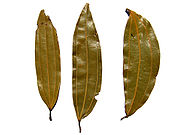 | Indian bay leaf, bay leaf | Tej Patta | तेज पत्ता | तमालपत्र | பட்டை | കറുവാപട്ട ഇല | బిర్యానీ ఆకు | ಮಸಾಲ ಎಲೆ/ಪುಲಾವ್ ಎಲೆ | তেজ পাতা tej pata | تيزپات | Both Indian bay leaf and bay leaf are similar and called as Tej Patta in Hindi. however, they are from two different species and have differences in taste | ||
| Cinnamon buds | Naaga Keshar | नाग केशर | नाग केशर | دارچینی | |||||||||
 | Cinnamon | Dalchini | दालचीनी | दालचिनी | તજ | இலவங்கப்பட்டை | കറുവപ്പട്ട | దాల్చిన చెక్క | ಚಕ್ಕೆ/ದಾಲ್ಚಿನ್ನಿ | দারচিনিdarchini | دارچینی | Grown commercially in Kerala in southern India. Two types, cassia (common) and royal. | |
 | Citric acid | Saji na phool | सजी न फूल | limboo na phool | سرکہ | ||||||||
 | Cloves | Laung | लवंग / लौंग | लवंग | લવિંગ | கிராம்பு, இலவங்கம் | ഗ്രാമ്പു/കരയാമ്പു | లవంగం | ಲವಂಗ | লং/লবঙ্গlông/lôbonggo | لوںگ | Andhra Pradesh, Kerala, Tamil Nadu and Karnataka are largest producers in India. | |
| Coriander powder | Dhania powder/ Pisa Dhania | धनिया पाउडर/पिसा धनिया | धणे पावडर | ધાણાજીરું | கொத்தமல்லி பொடி, தனியா | മല്ലിപ്പൊടി | ధనియాల పొడి, | ಕೊತ್ತಂಬರಿ ಪುಡಿ | ধনে গুঁড়া | دھنیہ | |||
 | Coriander seed | Dhania/hara dhaniya | धनिया | धणे | કોથમીર | விதை கொத்தமல்லி | മല്ലി | ధనియాలు | ಕೊತ್ತಂಬರಿ ಬೀಜ | ধনে dhone | دھنیا | ||
 | Cubeb | Kebab Cheeni / Kabab Chini | कबाब चीनी | नाकेश्वर | സര്വസുഗന്ധി | తోక మిరియాలు | কাবাব চিনিkabab chini | کباب چینی | Tastes of Clove + Persistent Mild Numbing + Bitterness | ||||
| Cumin seed grounded into balls | Jeera Goli | ज़ीरा गोली | 'జీలకర్ర వుండ' | ||||||||||
 | Cumin seed | Jeera | ज़ीरा | जिरं | જીરુ | சீரகம் | ജീരകം | జీలకర్ర | ಜೀರಿಗೆ | জিরা/গোটা জিরে | زیرہ | See Kali Jeera. | |
 | Curry tree or sweet neemleaf | Kadipatta (Currypatta) | करीपत्ता / कढ़ीपत्ता | कढीपत्ता | મીઠો લિમડો | கறிவேப்பிலை | കറിവേപ്പില | కరివేప ఆకు, | ಕರಿಬೇವು/ಕರಿಬೇವಿನ ಎಲೆ | কারিপাতা | کریاپات | Cannot retain flavour when dried. Only use fresh. | |
 | Fennel seed | Saunf/Sanchal | सौंफ / संचल | बडीशेप | variyali | பெருஞ்சீரகம்/சோம்பு | ജീരകം/പെരുംജീരകം | సోంపు | ಸೋಂಪು | মৌরি mouri | سوںف | ||
 | Fenugreek leaf | Kasoori Methi Dried | कसूरी मेथी | कसुरी मेथी | કસુરી મેથી | வெந்தய கீரை | ഉലുവ ഇല (ഉണക്കിയത്) | మెంతి ఆకులు, menthi aakulu | ಕಸ್ತೂರಿ ಮೆಂತ್ಯ | শুক্নো মেথি পাতাsukno methi pata | قصوری میتھی | ||
| Fenugreek leaf | Methi leaves | मेथी पत्ता | मेथीची पानं | வெந்தய கீரை | ഉലുവ ഇല | మెంతి ఆకులు, | ಮೆಂತ್ಯದ ಸೊಪ್ಪು | মেথি পাতাmethi pata | میتھی | ||||
 | Fenugreek seed | Methi seeds | मेथी दाना | मेथीचे दाणे | வெந்தயம் | ഉലുവ | మెంతులు, | ಮೆಂತ್ಯದ ಬೀಜ | মেথি methi | میتھی دانہ | |||
| Four seeds | Char Magaj | तरबूज खरबूज ककडी पैंठे के बीज | તરબૂચ ખરબૂચ કાકડી પૈંઠા ના બીયાં | মগজ | Seeds of Water melon, musk melon,cucumber and pumpkin | ||||||||
 | Garcinia gummi-gutta | Kudampuli | கொறுக்காய்ப்புளி | കുടംപുളി | গোম্বূজ gom booge | Used in fish preparations of Kerala | |||||||
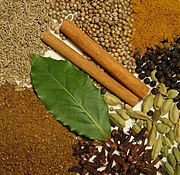 | Garam masala | Garam masala/Kadha Masala | गरम मसाला | गरम मसाला | ગરમ મસાલો | கரம் மசாலா | ഗരം മസാല | గరం మసాలా | ಗರಂ ಮಸಾಲಾ | গরম মশলাgôrom môshla | گرم مصالحہ | Blend of 8+ spices. Each family has their own secret recipe. | |
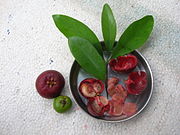 | Garcinia indica | Kokum | कोकम, | कोकम,आमसूल | કોકમ | ಮುರುಗದ ಹಣ್ಣು | কোকুম | کوکم | |||||
 | Garlic | Lahsun | लहसुन | लसूण | લસણ | வெள்ளை பூண்டு | വെളുത്തുള്ളി | వెల్లుల్లి పాయ, vellulli paaya | ಬೆಳ್ಳುಳ್ಳಿ | রসুন roshun | لہسن | ||
 | Ginger | Adrak | अदरक | आलं | આદુ | இஞ்சி | ഇഞ്ചി | అల్లం | ಶುಂಠಿ | আদা | ادرک | ||
 | Dried ginger | Sonth | सोंठ | सुंठ | સુંઠ | சுக்கு | ചുക്ക് | సొంఠి | ಒಣಶುಂಠಿ | শুকানো আদা গুড়ো | سونٹھ | mostly powdered | |
 | Green cardamom | Chhoti Elaichi | छोटी इलाइची | वेलची | એલચી | ஏலக்காய் | ഏലക്ക | ఏలకులు | ಏಲಕ್ಕಿ | ছোট এলাচ | چھوٹی الائچی | Malabar variety is native to Kerala. | |
| Indian Bedellium Tree | Gugul, Guggul | गुगल, गु्ग्गल | ગુ્ગળ | মাকাল | Very earthy aromatic mostly used in religious | ||||||||
 | Indian gooseberry | Amla | आँवला | आवळा | આમળા | நெல்லிக்காய் | നെല്ലിക്ക | ఉసిరి కాయ / పప్పు | ನೆಲ್ಲಿಕಾಯಿ | আমলকি | آملا | ||
 | Black salt | Kala Namak / Sanchal | काला नमक / संचल | काळं मीठ | સંચળ | இந்துப்பு | ഇന്തുപ്പ് | నల్ల ఉప్పు | ಕರಿ ಉಪ್ಪು | বিট নুন bit noon | کالا نمک | Rock salt, but with very sulfury smell. | |
| Kalpasi | Pathar Ka Phool | पत्थर के फूल | दगडफूल | દગડફૂલ | கல்பசி | కల్లుపచి, | ಕಲ್ಲು ಹೂವು | پتھر کا پھول | Also known as black stone flower | ||||
 | Licorice powder | Jethimadh | जेठीमध | ज्येष्ठमध | જેઠીમધ | அதிமதுரம் | ഇരട്ടിമധുരം
പൊടി
| యష్టిమధుక్కం | যশঠিমধুjjoshthi modhu | ملہٹی | |||
 | Long pepper | Pippali | पिप्पलि | पिंपळी | கண்டந்திப்பிலி | പിപ്പലി | అనాసపువ్వు | ಹಿಪ್ಪಲಿ | পিপুল | پپليان | |||
| Mango extract | Camiki | कामिकी | আমশী | ||||||||||
| Sour dried mango powder | Aamchur/Amchoor powder | आमचूर / अमचुर | आमचूर / आंबोशी | આમચૂર | আমচুড় | آمچور | |||||||
 | Mint | Pudina | पुदीना | पुदिना | ફુદિનો | புதினா | പുതിന | పుదీన | ಪುದಿನ | পুদিনা | پودینہ | ||
 | Mustard seed | Sarson | सरसों, | मोहरी | கடுகு | കടുക് | ఆవాలు, సరసావాలు, | ಸಾಸಿವೆ | সর্ষে, shorshe | سرسوں | |||
 | Brown mustard seed | Rai | राई | मोहरी | rai | கடுகு | കടുക് | ఆవాలు, | ಸಾಸಿವೆ | রাই/ সর্ষে / সরিষা shor say | رائی | ||
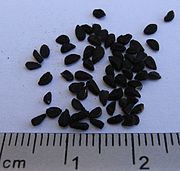 | Nigella seed | Kalonji | कलोंजी | कांद्याचे बी | கருப்பு எள் | నల్ల జీలకర్ర, | ತಂಪಿನ ಬೀಜ | কালো জিরাkalo jira | کلونجی | ||||
 | Nutmeg | Jaiphal | जैफल/जायफल | जायफळ | જાયફળ | ஜாதிக்காய் | ജാതിക്ക | జాజికాయ | ಜಾಕಾಯಿ/ಜಾಯಿಕಾಯಿ | জায়ফল | جاۓپھل | Whole nuts last forever. Powder, only a month. | |
 | Mace | Javitri | जावित्री | जायपत्री | જાવંત્રી | ஜாதிக்காய் | ജാതിപത്രി | జాపత్రి | ಜಾಪಾತ್ರೆ | জয়িত্রি | جاوتری | Mace is outer covering to nutmeg nut. Similar aroma. | |
 | Holy basil | Tulsi | तुलसी | तुळस | તુલસી | துளசி | തുളസി | తులసి, తులసి ఆకు | ತುಳಸಿ | তুলসী | تلسی | ||
 | Panch Phoron | Panch Phoron | पञ्च फोरन | পাঁচ ফোড়নpãch foṛon | This is a Bengali spice mix that combines aniseed, cumin, fenugreek, mustard and nigella | ||||||||
 | Pomegranate seed | Anardana | अनारदाना | डाळींबदाणे | દાડમ ના બીયા | மாதுளம் விதை | മാതളനാരങ്ങ കുരു/അല്ലി | దానిమ్మ, గింజలు | ದಾಳಿಂಬೆ ಬೀಜ | আনারদানা/ বেদানার বীজ | اناردانا | Dried not fresh. Is ground in Middle East. | |
 | Poppy seed | Khus Khus | खस-खस | खसखस | ખસખસ | கச கசா | കസകസ | గసగసాలు | ಗಸಗಸೆ | পোস্ত posto | خشحش | ||
| Saffron pulp | Kesar mari mari | केसर मिरी मिरी, | குங்குமப்பூ | కుంకుమ పూల పొడి | ಕೇಸರಿಹೂ | কেশর মড়মড়ি | Actually, safflower concentrate | ||||||
 | Saffron | Kesar, mayur | केसर, जाफरान | केशर | kesar | குங்குமப்பூ | കുങ്കുമ പുവ് | కుంకుమ పువ్వు, | ಕೇಸರಿ | জাফরান jafran | زعفران | World's most expensive spice. Flavouring for rice. | |
| Salt | Namak | नमक | मीठ | mithoo | உப்பு | ഉപ്പ് | ఉప్పు, uppu | ಉಪ್ಪು | লবণ/নুনlôbon/nun | نمک | |||
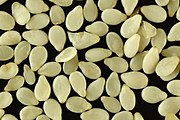 | Sesame seed | Til | तिल | तीळ | તલ | எள் | എള്ള് | నువ్వులు | ಎಳ್ಳು/ಕರಿ ಎಳ್ಳು | তিল | تل | ||
 | Star anise | Chakra Phool | चक्र फूल, बदल फुल | चक्र फूल | બાદીયા | அண்ணாச்சி மொக்கு | തക്കോലം | అనసపువ్వు | ಚಕ್ರ ಮೊಗ್ಗು /ಹೂವ್ವು | তারা মৌরী | باديان خطائى | Exotic, Chinese-influenced flavours | |
 | Tamarind | Imli | इमली | चिंच | આમલી | புளி | പുളി/വാളന്പുളി | చింతపండు | ಹುಣಸೆಹಣ್ಣು | তেঁতুল tetul | املی | Provides tartness in South Indian curries | |
 | Carom/thymol seed | Ajwain | अज़वाइन | ओवा | અજમો | ஓமம் | അയമോദകം | వాము | ಓಮಕಾಳು | জোয়ান | اجوائن | ||
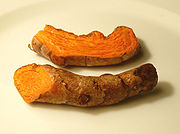 | Turmeric | Haldi | हल्दी | हळद | હળદર | மஞ்சள் | മഞ്ഞള് | పసుపు | ಅರಿಶಿನ/ಹಳದಿ | হলুদ holud | ہلدی | Source of "yellow color" in many curries. | |
| Fresh basil | Tulsi | तुलसी | तुळस | તુલસા | துளசி | തുളസി | తులసి | ತುಳಸಿ | তুলসী | تُلسی | |||
 | Fresh coriander | Hara dhaniya | हरा धनिया | कोथिंबीर | લીલી કોથમીર | கொத்தமல்லி (இலை) | മല്ലിയില | కొత్తిమీర | ಕೊತ್ತಂಬರಿ ಸೊಪ್ಪು | ধনে পাতা | کوتمیر ھرا دھنیا | Fresh green leaves. AKA Cilantro. | |
 | Green chili pepper | Hari Mirch | हरी मिर्च | हिरवी मिरची | લીલું મરચું | பச்சை மிளகாய் | പച്ച മുളക് | పచ్చి మిరపకాయలు | ಹಸಿ ಮೆಣಸಿನಕಾಯಿ | কাঁচা মরিচ/ কাঁচা লঙ্কা kãcha morich / kãcha lonka | ہری مرچ | ||
| Gum tragacanth | Katira Goond | कटीरा गोंद | डिंक | gundar | কাতিলা | کٹیرا | A thickener and coating for desserts | ||||||
 | Inknut Terminalia chebula | Harad / Harr /Haritaki | हरद | हिरडा/हरडा | હરડે | கடுக்காய் | കടുക്ക | కరక చెట్టు, | ಅಳಲೆಕಾಯಿ | হরিতকি | حرر | ||
| Red chili pepper | Lal Mirchi | लाल मिर्च | लाल मिरची | લાલ મરચું | மிளகாய் வத்தல் | വറ്റല് മുളക്, ഉണക്ക മുളക് | మిరప కాయలు, | ಕೆಂಪು ಒಣಮೆಣಸಿನಕಾಯಿ | লাল মরিচ lal morich | لال مرچ |
